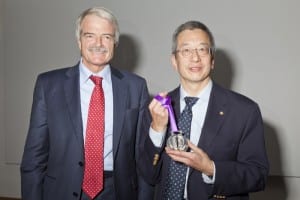UCL 2011 Prize Lecture in Clinical Science with Roger Tsien
By James M Heather, on 26 October 2011
For the past 14 years, the UCL Prize Lecture in Clinical Science has brought some of the most pre-eminent names from the medical sciences here to Bloomsbury to regale us with their data, and this year’s offering was no different.
Professor Roger Y. Tsien, from the University of California, San Diego has received almost as many scientific awards, accolades and honours as it’s possible to get in one lifetime, primarily for his research on Green Fluorescent Protein (GFP).
GFP is a protein found in jellyfish that is able to emit light without the need for other proteins or factors. GFP was discovered in the 1960s, but it wasn’t until the late 1980s that it began to gather attention as a possible marker of gene expression.
In the early 1990s, Tsien and his researchers took the natural GFP gene sequence, evolved by jellyfish over millions of years for their own purposes, and tweaked it to suit the needs of the laboratory. By mutating this gene, Tsien and his group were able to make the light emitted by GFP brighter, and shift it to a more useful wavelength. Moreover, they were able to generate a variety of different fluorescent proteins, in a veritable palette of colours. By tagging different proteins with different fluorescent colours, researchers were able for the first time to visualise protein interactions in cells and in real-time under the microscope.
The implications of the fluorescent proteins were profound, and so with good cause Roger Tsien was one of three scientists who shared the 2008 Nobel Prize for Chemistry.
In the lecture, however, Tsien was keen to point out that GFP is but one string to his bow, representing just a fraction of his work.
After his youthful passion for chemistry wilted studying undergraduate organic chemistry, Tsien instead turned his attention to neurobiology. Wishing to image neurons firing, he eventually struck upon the idea of instead visualising calcium dynamics as a surrogate measure of action potential.
Accordingly, Tsien synthesised a fluorescent chemical that would allow just that; direct real-time imaging of calcium movement within a cell, providing a technique that has far flung applications across biology.
With calcium in the bag, he then synthesised dyes for other important biological markers. It was the production of these individually tailored stains that inspired him to find a universally applicable, genetically encoded tag, which set his feet on the path to GFP.
In what he deems the last ‘age’ of his research, Tsien is now keen to move away from solely providing tools for others to do clinical research, and work towards doing some himself. With that in mind, he presented data for several of his current projects.
Perhaps the most interesting of his recent work is the development of peptides that are selectively absorbed by tumour cells, a project of particular poignancy to Tsien, having lost several family members to cancer. When combined with a fluorescent cargo, these peptides can be administered before surgery, turning tumours bright blue or green on a monitor, making a surgeon’s job much easier.
He delivered the lecture wonderfully, with a wry and modest sense of humour, revealing how his personal neuroses drive him to succeed, and how by avoiding what’s popular he found research areas devoid of competition. The whole talk was also flavoured with his appreciation of aesthetics, and how much of his work has been driven by a love of pretty colours.
Roger Tsien is clearly both a remarkable man and a wonderful scientist. Time and again he has used the power of chemistry, applied to the interesting problems thrown up by biology, and come up with a solution. We are very lucky to have had him here for this lecture.
Through his work we can see the inner workings of life as never before.
Watch the lecture online here:
 Close
Close


